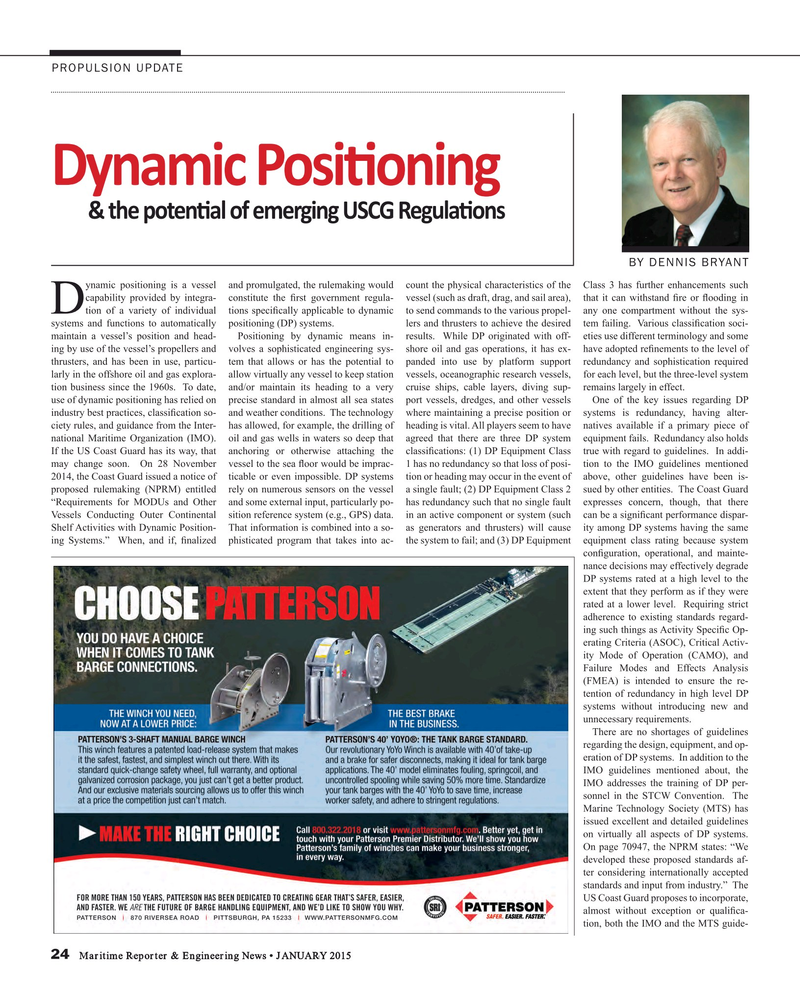
Page 24: of Maritime Reporter Magazine (January 2015)
Ship Repair & Conversion Edition
Read this page in Pdf, Flash or Html5 edition of January 2015 Maritime Reporter Magazine
PROPULSION UPDATE
Dynamic Posit oning & the potent al of emerging USCG Regulat ons
BY DENNIS BRYANT ynamic positioning is a vessel and promulgated, the rulemaking would count the physical characteristics of the Class 3 has further enhancements such capability provided by integra- constitute the ? rst government regula- vessel (such as draft, drag, and sail area), that it can withstand ? re or ? ooding in
Dtion of a variety of individual tions speci? cally applicable to dynamic to send commands to the various propel- any one compartment without the sys- systems and functions to automatically positioning (DP) systems. lers and thrusters to achieve the desired tem failing. Various classi? cation soci- maintain a vessel’s position and head- Positioning by dynamic means in- results. While DP originated with off- eties use different terminology and some ing by use of the vessel’s propellers and volves a sophisticated engineering sys- shore oil and gas operations, it has ex- have adopted re? nements to the level of thrusters, and has been in use, particu- tem that allows or has the potential to panded into use by platform support redundancy and sophistication required larly in the offshore oil and gas explora- allow virtually any vessel to keep station vessels, oceanographic research vessels, for each level, but the three-level system tion business since the 1960s. To date, and/or maintain its heading to a very cruise ships, cable layers, diving sup- remains largely in effect.
use of dynamic positioning has relied on precise standard in almost all sea states port vessels, dredges, and other vessels One of the key issues regarding DP industry best practices, classi? cation so- and weather conditions. The technology where maintaining a precise position or systems is redundancy, having alter- ciety rules, and guidance from the Inter- has allowed, for example, the drilling of heading is vital. All players seem to have natives available if a primary piece of national Maritime Organization (IMO). oil and gas wells in waters so deep that agreed that there are three DP system equipment fails. Redundancy also holds
If the US Coast Guard has its way, that anchoring or otherwise attaching the classi? cations: (1) DP Equipment Class true with regard to guidelines. In addi- may change soon. On 28 November vessel to the sea ? oor would be imprac- 1 has no redundancy so that loss of posi- tion to the IMO guidelines mentioned 2014, the Coast Guard issued a notice of ticable or even impossible. DP systems tion or heading may occur in the event of above, other guidelines have been is- proposed rulemaking (NPRM) entitled rely on numerous sensors on the vessel a single fault; (2) DP Equipment Class 2 sued by other entities. The Coast Guard “Requirements for MODUs and Other and some external input, particularly po- has redundancy such that no single fault expresses concern, though, that there
Vessels Conducting Outer Continental sition reference system (e.g., GPS) data. in an active component or system (such can be a signi? cant performance dispar-
Shelf Activities with Dynamic Position- That information is combined into a so- as generators and thrusters) will cause ity among DP systems having the same ing Systems.” When, and if, ? nalized phisticated program that takes into ac- the system to fail; and (3) DP Equipment equipment class rating because system con? guration, operational, and mainte- nance decisions may effectively degrade
DP systems rated at a high level to the extent that they perform as if they were rated at a lower level. Requiring strict adherence to existing standards regard- ing such things as Activity Speci? c Op- erating Criteria (ASOC), Critical Activ- ity Mode of Operation (CAMO), and
Failure Modes and Effects Analysis (FMEA) is intended to ensure the re- tention of redundancy in high level DP systems without introducing new and unnecessary requirements.
There are no shortages of guidelines regarding the design, equipment, and op- eration of DP systems. In addition to the
IMO guidelines mentioned about, the
IMO addresses the training of DP per- sonnel in the STCW Convention. The
Marine Technology Society (MTS) has issued excellent and detailed guidelines on virtually all aspects of DP systems.
On page 70947, the NPRM states: “We developed these proposed standards af- ter considering internationally accepted standards and input from industry.” The
US Coast Guard proposes to incorporate, almost without exception or quali? ca- tion, both the IMO and the MTS guide- 24 Maritime Reporter & Engineering News • JANUARY 2015
MR #1 (18-25).indd 24 MR #1 (18-25).indd 24 1/7/2015 9:56:21 AM1/7/2015 9:56:21 AM

 23
23

 25
25
